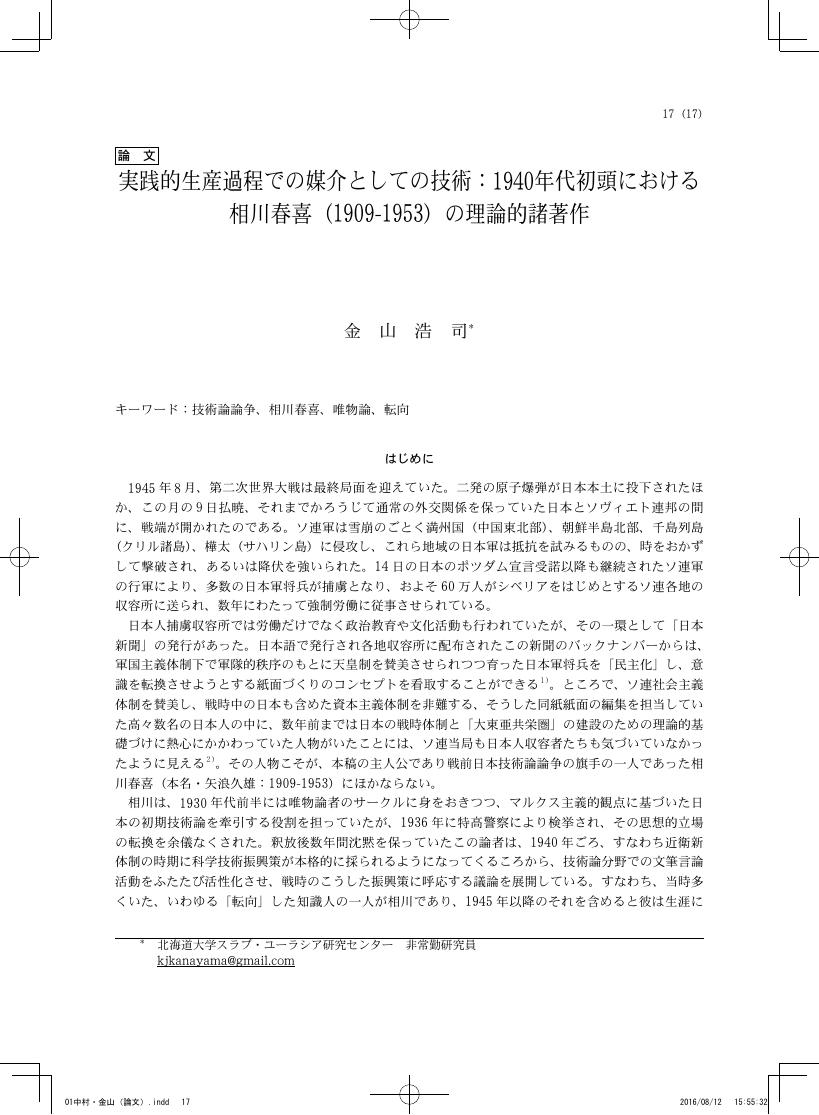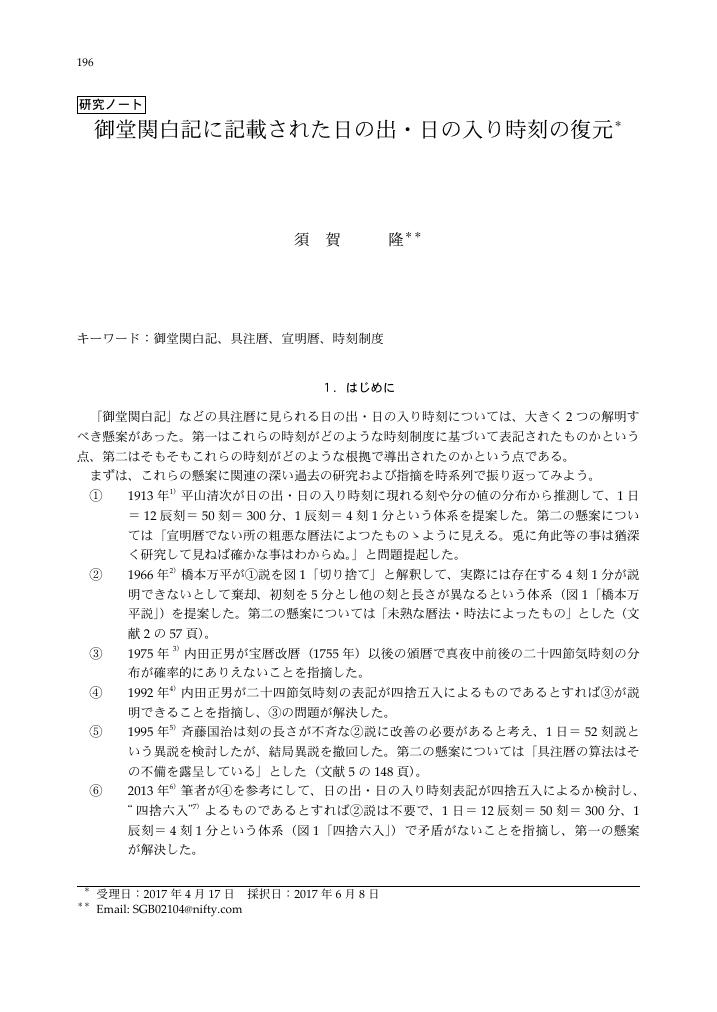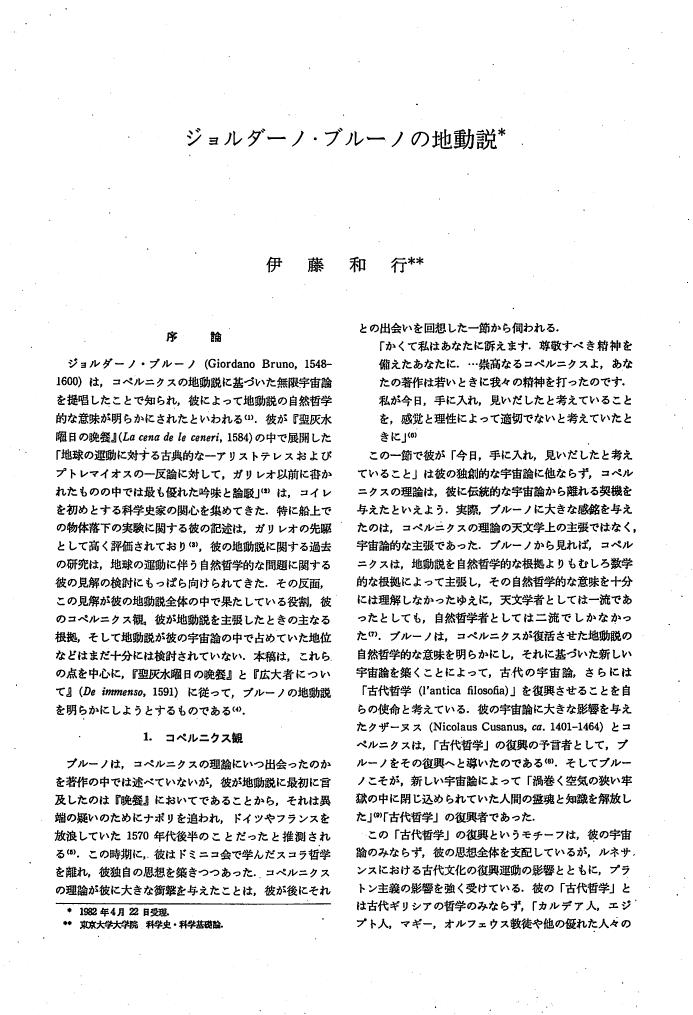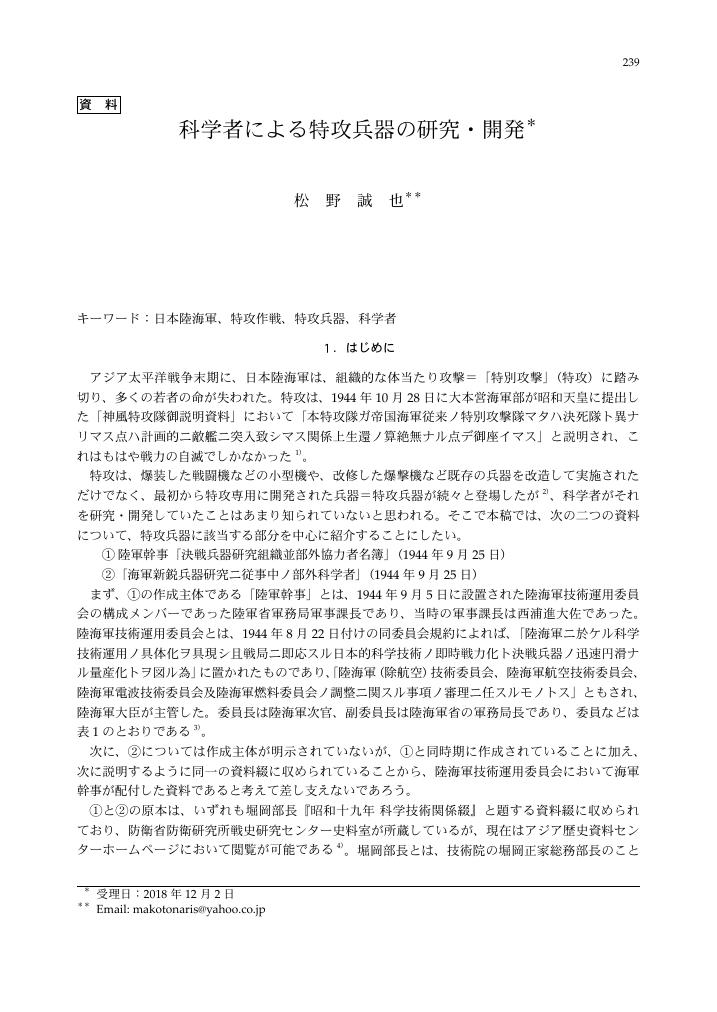4 0 0 0 OA 広島・長崎の原爆放射線影響研究 -急性死・急性傷害の過小評価-
- 著者
- 中川 保雄
- 出版者
- 日本科学史学会
- 雑誌
- 科学史研究 (ISSN:21887535)
- 巻号頁・発行日
- vol.25, no.157, pp.20-33, 1986 (Released:2021-04-05)
4 0 0 0 OA 小特集 「進化論誤用・悪用・濫用」問題
- 出版者
- 日本科学史学会
- 雑誌
- 科学史研究 (ISSN:21887535)
- 巻号頁・発行日
- vol.60, no.299, pp.245, 2021 (Released:2022-08-01)
4 0 0 0 OA 資料 : イブン・アル=ハイサム『光についての論述』
- 著者
- 甲子 雅代
- 出版者
- 日本科学史学会
- 雑誌
- 科学史研究 (ISSN:21887535)
- 巻号頁・発行日
- vol.33, no.191, pp.143-151, 1994 (Released:2021-03-22)
4 0 0 0 OA 近代西洋科学用語の中日貸借対照表
- 著者
- 中山 茂
- 出版者
- 日本科学史学会
- 雑誌
- 科学史研究 (ISSN:21887535)
- 巻号頁・発行日
- vol.31, no.181, pp.1-8, 1992 (Released:2021-03-25)
- 著者
- 金山 浩司
- 出版者
- 日本科学史学会
- 雑誌
- 科学史研究 (ISSN:21887535)
- 巻号頁・発行日
- vol.54, no.273, pp.17, 2015 (Released:2020-12-14)
AIKAWA Haruki, one of the prominent theorists of technology study in Japan in the prewar period, put forward fresh philosophical understandings of technology in the first days of the 1940s. He saw the unification of the subjective humanity and objective material in the dynamic process of production and regarded technology as a medium of such unification. By investigating his books published in the period of the Konoe's New Order, present paper seeks to reveal how Aikawa acquired his own idea on technology. It also aims to put the improvement of his thought in the sociopolitical context of wartime Japan. In the first half of the 1930s, Aikawa had a materialistic view: that is, he observed that the nature of technology was represented in the means of labor in itself. Although Aikawa's idea was accepted among members of the Society for the Study of Materialism as one of the possible Marxist understandings of technology, it was also criticized for ignoring the importance of the subjective labor force in the process of production. After his arrest as a suspected communist sympathizer in 1936, Aikawa abandoned his previous standpoint and came to be a spokesman of the war policy of Imperial Japan. We should not regard this alternating process as a simple conversion under the suppression of the Japanese militarists, however. Aikawa certainly made a compromise, but at the same time, he intended to develop his idea on technology by accepting criticism by materialists. In such a process Aikawa succeeded in making his thought a more balanced one.
4 0 0 0 OA 御堂関白記に記載された日の出・日の入り時刻の復元
- 著者
- 須賀 隆
- 出版者
- 日本科学史学会
- 雑誌
- 科学史研究 (ISSN:21887535)
- 巻号頁・発行日
- vol.56, no.283, pp.4, 2017 (Released:2021-01-10)
- 著者
- 市川 浩
- 出版者
- 日本科学史学会
- 雑誌
- 科学史研究 (ISSN:21887535)
- 巻号頁・発行日
- vol.59, no.295, pp.199-213, 2020 (Released:2021-01-24)
4 0 0 0 科学普及活動家ルイ・フィギエと死後の魂をめぐる問題
- 著者
- 槙野 佳奈子
- 出版者
- 日本科学史学会
- 雑誌
- 科学史研究 (ISSN:21887535)
- 巻号頁・発行日
- vol.59, no.294, pp.99-112, 2020 (Released:2021-01-24)
4 0 0 0 共同利用研究所における自治の相克
- 著者
- 平田 光司 高岩 義信
- 出版者
- 日本科学史学会
- 雑誌
- 科学史研究 (ISSN:21887535)
- 巻号頁・発行日
- vol.59, no.293, pp.38-52, 2020 (Released:2021-01-24)
Inter-University Research Institutes (IURIs) are supposed to be shared properties of the researchers of corresponding disciplines. The Institute of Nuclear Study (INS) affiliated to the University of Tokyo was the first IURI equipped with large scientific facilities. A newly found set of records, collected and archived by Hiroo Kumagai, a former professor of INS, gives us new insights and interpretation of the history of the INS and its successors. INS was designed to be managed democratically on the sole basis of the common will of all nuclear physicists in Japan (the autonomy of the research community). It conflicted with the principle of the autonomy of the university. It is shown that the conflict of the two different kinds of autonomy was one of the motivations to create a new, larger physics institute, the Laboratory for High Energy Physics (KEK). Because of this historical background, KEK and other newer IURIs could provide “virtual” autonomy for researchers, though they are formally the institutes operated by the government.
- 著者
- 渡邊 洋之
- 出版者
- 日本科学史学会
- 雑誌
- 科学史研究. [第Ⅲ期] = Journal of history of science, Japan. 日本科学史学会 編 (ISSN:21887535)
- 巻号頁・発行日
- no.270, pp.169-181, 2014-07
This paper discusses some facts that were pivotal in the process of the introduction of Bluegill Sunfish, Lepomis macrochirus, into various places in Japan, however have not been considered in the existing literature. This paper points out that L.macrochirus escaped, and also was stocked, to the open water in Osaka as a result of experiments by a fisheries experimental station in the 1960s and early 1970s. In Shiga Prefecture too, the fish escaped into Lake Biwa as a result of experiments by a fisheries experimental station in about 1969. Neither Osaka nor Shiga are mentioned, by previous studies based on questionnaire research, as the prefectures in which L.macrochirus inhabited in the years between 1960, when the fish was first introduced into Japan, and 1979. In addition, anglers, who considered L.macrochirus an ideal game fish, stocked ponds and lakes in some prefectures with L.macrochirus in around 1970 on purpose to multiply the species. During this process, a network among not only local governments, fisheries experimental stations, and fish farmers, but also industries targeting anglers, such as fishing tackle makers and a magazine for anglers, was being formed, which however did not get established after all. These findings will contribute to enrich the basis of today's genetic research on the distribution of L.macrochirus in Japan.
- 著者
- 隠岐 さや香 有賀 暢迪
- 出版者
- 日本科学史学会
- 雑誌
- 科学史研究. [第Ⅲ期] = Journal of history of science, Japan. 日本科学史学会 編 (ISSN:21887535)
- 巻号頁・発行日
- no.275, pp.240-247, 2015-10
- 著者
- 有賀 暢迪
- 出版者
- 日本科学史学会
- 雑誌
- 科学史研究. [第III期] (ISSN:21887535)
- 巻号頁・発行日
- vol.53, no.272, pp.473-479, 2015-01-31
- 著者
- 水沢 光
- 出版者
- 日本科学史学会
- 雑誌
- 科学史研究. [第Ⅲ期] = Journal of history of science, Japan. 日本科学史学会 編 (ISSN:21887535)
- 巻号頁・発行日
- no.272, pp.379-396, 2015-01
This paper analyzes the distribution of the Subsidiary Fund for Scientific Research, a predecessor to the Grant-in-Aid for Scientific Research (KAKENHI), which operated in Japan from the 1930s to 1950s. It reveals that the Japanese government maintained this wide-ranging promotion system since its establishment during the war until well into the postwar period. Previous studies insist that, at the end of the war, the Japanese government generally only funded the research that it considered immediately and practically useful. In contrast to this general perception, my analysis illustrates that both before and after the war, funding was allotted to four research areas: natural science, engineering, agriculture, and medicine. In order to illuminate this continuity, I compare the Subsidiary Fund with another research fund existing from 1933 to 1947: the Grant of the Japan Society for the Promotion of Science (JSPS). The comparison demonstrates that the JSPS received externally raised capital from the military and munitions companies. However, while this group focused upon engineering and military-related research as the war dragged on, the Subsidiary Fund has consistently entrusted scientists with the authority to decide the allocation of financial support.
- 著者
- 廣川 和花
- 出版者
- 日本科学史学会
- 雑誌
- 科学史研究. [第III期] (ISSN:21887535)
- 巻号頁・発行日
- vol.53, no.271, pp.293-295, 2014-10-24
3 0 0 0 OA 外国における"血液型パーソナリティの関係"をめぐる研究
- 著者
- 溝口 元
- 出版者
- 日本科学史学会
- 雑誌
- 科学史研究 (ISSN:21887535)
- 巻号頁・発行日
- vol.32, no.187, pp.152-156, 1993 (Released:2021-03-23)
3 0 0 0 OA ジョルダーノ・ブルーノの地動説
- 著者
- 伊藤 和行
- 出版者
- 日本科学史学会
- 雑誌
- 科学史研究 (ISSN:21887535)
- 巻号頁・発行日
- vol.21, no.142, pp.81-87, 1982 (Released:2021-05-13)
3 0 0 0 OA 曲直瀬道三撰『医心正伝』の研究 : 「察証弁治」形成の過程とその変遷
- 著者
- 遠藤 次郎 鈴木 琢也 中村 輝子
- 出版者
- 日本科学史学会
- 雑誌
- 科学史研究 (ISSN:21887535)
- 巻号頁・発行日
- vol.41, no.223, pp.129-137, 2002 (Released:2021-08-13)
Sanki Tashiro and Dosan Manase are known for their role as founders of the Gosei-ha school in Japan. Observing that Japanese medicine had not been based on a clear theory, they introduced into Japan the satsusho benchi practiced in Chinese medicine during the Jin and Yuan dynasties. The basis of this system was to examine the patient's condition, then determine the treatment accordingly. Dosan Manase in particular employed the satsusho benchi, writing out a new prescription each time treatment was required, without reference to existing prescriptions. In this study, we carried out an investigation into the "Ishin shoden" edited by Dosan Manase, which reveals the process by which Dosan established the new satsusho benchi system of medicine within the framework of traditional Japanese medicine. In the early stages of the process, Dosan prepared prescriptions based on existing iou-tou prescriptions, modifying these by adding or removing medicines. Then, in the middle period, he prepared prescriptions based on toso-tou prescriptions, designed on the basis of the kun shin sa shi or Junchen Zuoshi theory, again modifying these by adding or removing medicines. In the final stage of the process, Dosan ceased this practice of adding or removing medicines from a basic prescription, adopting instead the satsusho benchi system of writing out a new prescription for every treatment. In addition, we consider the reasons why the satsusho benchi system was not employed by Dosan's successors, and discuss the effects of this.
3 0 0 0 OA 科学者による特攻兵器の研究・開発
- 著者
- 松野 誠也
- 出版者
- 日本科学史学会
- 雑誌
- 科学史研究 (ISSN:21887535)
- 巻号頁・発行日
- vol.58, no.291, pp.239-248, 2019 (Released:2021-01-24)
3 0 0 0 OA デュアルユース発明の秘密特許化 : 民生産業における懸念
- 出版者
- 日本科学史学会
- 雑誌
- 科学史研究 (ISSN:21887535)
- 巻号頁・発行日
- vol.60, no.299, pp.234, 2021 (Released:2022-08-01)
3 0 0 0 OA 旧制第一高等学校に学んだ初期京師大学堂派遣の清国留学生について
- 著者
- 薩 日娜
- 出版者
- 日本科学史学会
- 雑誌
- 科学史研究 (ISSN:21887535)
- 巻号頁・発行日
- vol.49, no.256, pp.216-226, 2010 (Released:2021-07-22)
This paper investigates the activities of early Chinese students who were dispatched by the Imperial University of Peking (京師大学堂) to the First High School (第一高等学校) in Japan. It is based on original sources which remain partly unsorted. First, the correspondence between the Late Qing's minister of Education Zhang Baixi (張百煕) and the Imperial University of Peking's Japanese teacher Hattori Unokichi (服部宇之吉) will be analyzed, which reveals details about motives and circumstances of the dispatch project. Secondly, documents preserved at the University of Tokyo show the study life and, in particular, mathematics education offered to the foreign students in the First High School. Thirdly, the contribution of the whole project to the modernization of mathematics, natural science and technology in China will be examined, on the basis of achievements of those students after their return.











